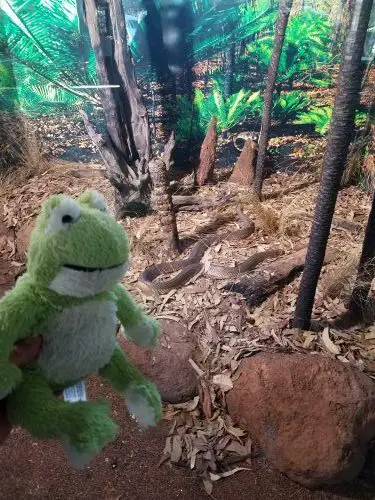Frank and Joanna with Woggie the Froggie meet a Australian Snake
Frank and Joanna with Woggie the Froggie meet a Australian Snake
General facts about Australian snakes
Snakes are cold-blooded. They can’t regulate their body temperature internally like mammals do. Snakes need the sun, or at least warm air temperature for their body heat. The colder it is, the more inactive snakes become. That’s why snakes like basking in the sun.
Senses: Snakes can see, smell and hear. Most snakes have fairly good eyesight, at least over short distances. They hear with an inner ear that picks up vibrations from the ground. But their most important sense is the sense of smell. Snakes smell by flicking their tongues in and out their mouth.
Breeding: Some snakes lay eggs, while others give birth to living young.
Non-venomous Australian snakes include pythons, file snakes (a sea snake), and blind snakes. The amethystine python is by far the longest snake in Australia, it grows up to 5 – 6 metre. They live in northern tropical Queensland, mostly in rain forests.
The most dangerous snakes in Australia
The Coastal and Inland Taipan
The coastal Taipan (Oxyuranus scutellatus), or eastern Taipan, is Australia’s most notorious snake, and the longest of the venomous snakes.
It can grow up to 3m, the average taipan is 2,5 m. Sometimes it gets confused with other large brownish snakes. The typical feature to distinguish it from other snakes is the Taipan’s pale face and large head.
When the snake feels threatened, or cornered, it defends itself without warning. When the coastal Taipan strikes, it usually injects a large amount of venom.
Before the development of anti-venom in the 1950s bites from the taipan where mostly fatal. Victims should seek medical treatment immediately.
The taipan inhabits the coastal areas in Australia’s north and north east, from Brisbane to Darwin.
The Inland Taipan (Oxyuranus microlepidotus) is also known as fierce snake, or lignum snake. It is not as big as the coastal taipan.
As the name tells, this is a snake of the Australian Outback. The fierce snake can be found in the Channel Country of south west Queensland, north east of South Australia, and in the north west of New South Wales.
The Inland Taipan varies from yellowish-brown to dark brown, it is usually darker in winter. It is a shy snake that shelters in cracks and holes. However, if it feels provoked, it will strike, after raising its forebody to give a warning. If the offender ignores the warning, the snake strikes and injects its most potential venom.
Although the fierce snake is known as the most dangerous, and the world’s most venomous snake, there are not many people bitten by this snake, due to the remote environment it calls home.
Brown Snakes
The Common or Eastern Brown Snake (Pseudonaja textilis) can be found in the eastern half of Australia. They live in open woodlands, in rural areas, but can be found at suburban peripheries of larger towns and cities as well.
The output of venom is low because of its undersized fangs. However, brown snakes cause more deaths in Australia than any other snake. Firstly, the venom is very potential, and secondly, due to the large numbers, they are most like to come in contact with humans.
Most of the bites by a brown snake are the result of people trying to move, kill or otherwise handle the snake.
The Dugite and Gwardar belong to the same snake family. Victims of these Australian snakes respond quite well to the anti-venom.
The Mulga snake belongs to the black snake family, not to the brown snakes. This is important to know when a bite needs to be treated, because a different anti-venom is required.
This site contains product affiliate links. We may receive a commission if you make a purchase after clicking on one of these links.


